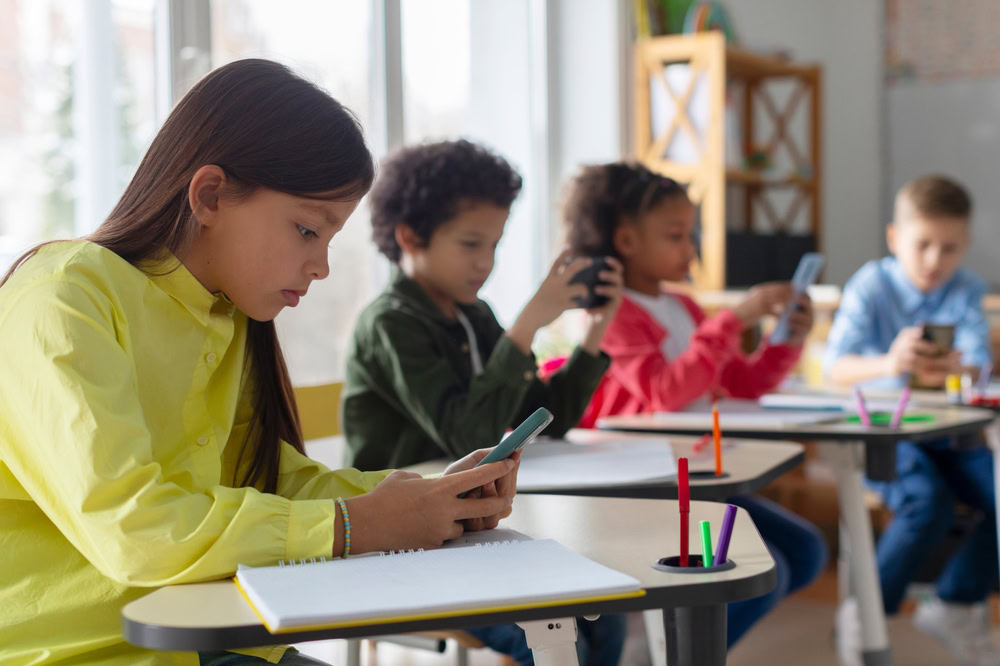In the morning before class starts, one by one the students at the Würenloser Gesamtschule near Zürich in Switzerland turn off their smartphones and drop them into a simple wooden box at the front of their classroom. The devices will remain there until the gong rings at the end of their school day. “I don’t even take it to school anymore,” one 12th-grader says. “It only distracts me.” His peers agree. “We talk more with each other instead of everybody staring at their screens,” his friend says.
As this school year gets underway, a growing number of schools are banning or restricting smartphones. France has banned them in primary and secondary schools since 2018, the Netherlands since the beginning of this year, and Italy, Germany and Great Britain are currently discussing implementing restrictions. In the US, Florida passed a law last year that bars students from using personal digital devices in public schools, and several other states, including Indiana, Louisiana and South Carolina, are following suit starting this school year.

According to recent Pew research, 70 percent of high school teachers believe phone distraction is a “major problem,” and a third of students say they are distracted by digital devices during lessons. On average, US teenagers spend nearly five hours a day on social media, according to a recent Gallup survey. The social psychologist Jonathan Haidt, who wrote the bestseller The Anxious Generation, expresses concern about the “rewiring” of an entire generation and sees clear links between rising phone addiction and declining mental health. Surgeon General Vivek Murthy, too, warns of a “profound risk of harm” to young people, noting that adolescents 12 to 15 who spend more than three hours a day on social media are at twice the risk of depression and anxiety as nonusers. Recent findings from the extensive international PISA survey highlight a negative correlation between leisurely digital device use and academic performance. The OECD (Organisation for Economic Co-operation and Development) warns that “excessive screen time can impact children’s social and emotional development.”
However, newly implemented phone bans have been met with protests from students and from parents who want to be able to reach their kids during the day. Many teachers complain that keeping students off their phones is a constant struggle, and they look with disbelief at schools like Würenlos that seem to manage the ban effortlessly.
Lukas Müller, the Würenlos school director, attributes the success of the ban to several factors. For one, the school board agreed way back in 2007 to keep phones out of classrooms. “But it led to students using them incessantly in the breaks or taking bathroom breaks to look at their phones,” remembers Müller, who has been at the school since 2004. “That was just at the start of the iPhone boom.” Studies show that requests to turn off their phones while students are allowed to keep the devices with them during class are rarely successful, and up to 97 percent of students can’t resist the temptation to check their emails or apps. So the board decided the following year to ban phone use in the entire school area. “The students are indeed less distracted,” Müller has observed. And because his K-12 school starts at kindergarten and teaches students all the way through senior year, students get used to being phoneless in school long before they become attached to Instagram or TikTok.
Weighed down by negative news?
Our smart, bright, weekly newsletter is the uplift you’ve been looking for.In Switzerland, each school can decide what it thinks is best. “The vast majority of parents are grateful we don’t allow phones in class,” Müller says, and he knows all the tricks. “Of course we had students who dropped off a second or old phone and kept using their main cell phone.” If a student is caught using their phone in school, they get an entry into their report card, and after three instances, the parents are invited to a chat.
But the solution isn’t as simple as banning all digital devices. The problem isn’t the use of these devices per se, but excessive use and the kind of content students access. Students who spend one to five hours per day on digital devices for learning at school score significantly higher in their mathematics lessons than those who spend no time on such devices, the OECD concludes: “In contrast, students spending over one hour on digital devices for leisure at school score more than nine points lower in mathematics and report a lower sense of belonging at school than students who spend no time on leisure digital activities.”

That’s why Würenlos doesn’t just ban all digital devices in school, and this is another reason why students and parents approve of the ban. “We educate the students about a responsible use of smartphones and apps,” Müller says, which is exactly what the OECD recommends. Through its own school app, Würenlos parents can reach their kid’s teachers at any time, and the 740 students can communicate with each other respectfully. From kindergarten onward, the school supplies students with tablets equipped with content filters and seniors with notebooks loaded with educational software. “Teachers teach the students how to use social media responsibly, for instance, there is never just one administrator in charge of an online group, so one student can’t exclude another student,” Müller gives as an example. From sixth grade onwards, the school invites police once a year to explain cyberbullying and alert students to potential online traps.
Despite all the precautions, Müller has observed an increase in cyberbullying at Würenlos. “The smartphone bans can’t prevent that,” he acknowledges. When cyberbullying occurs, the teachers inform the parents and discuss reasonable boundaries for digital communication at parent-teacher conferences.
Maybe most importantly, if the smartphone use is a problem, the real problem might not be the smartphone. “Often, there are other, underlying issues, and the student is isolating themselves,” Müller knows. “When parents feel out of their depths and tell us their kid spends hours on the phone each evening, we invite them to a talk with us and the social worker, and we agree on limits.”
This is another crucial OECD recommendation: “Strengthening collaboration between educators, parents and students to shape and implement policies regarding the use of digital devices, which could lead to a more balanced and effective approach to the issue.”
And finally, most experts, teachers and parents agree that simply taking devices away is not a successful strategy. Kids need alternatives that prove more enriching than digital temptations. “We have very active sports clubs, a third of our students play an instrument, and the students talk to each other in the breaks,” Müller says about Würenlos students.
A 10th-grader agrees: “It’s better we play soccer in the breaks than if everybody just stares at their phone.”












